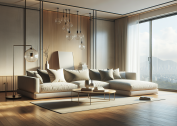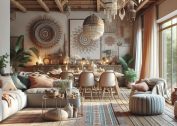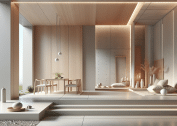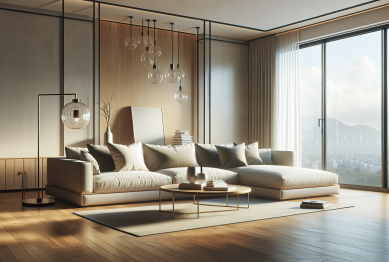Discover how biophilic design helps create spaces that boost mood, energy, and well-being. This practical guide reveals the subtle ways natural elements can transform lifestyles and living spaces for a healthier, more fulfilling environment.
Why Biophilic Design Captures Attention
Biophilic design invites the outdoors inside, creating vibrant, nature-inspired living environments. Its popularity has rapidly grown among designers and homeowners eager for homes that promote well-being and sustainable living. This lifestyle trend does more than beautify rooms—it fosters a direct connection to nature. Whether it’s placing a lush plant in a cozy nook, maximizing sunlight, or using materials like reclaimed wood, each element works harmoniously to evoke calm and creativity. The main idea? A home that genuinely feels alive and comfortable.
People are increasingly drawn to biophilic design because of the mounting evidence linking our surroundings to psychological health. Studies from various wellness organizations highlight how even a small dose of greenery or natural materials can reduce stress and improve overall mood (Source: https://www.apa.org/monitor/2019/09/nurtured-nature). Beyond psychology, environments that echo nature tend to boost creativity and productivity, making them especially relevant to remote professionals who seek comfort and efficiency within their homes.
There’s also a sustainability angle: biophilic design encourages eco-friendly choices in furniture, materials, and even energy usage. Homeowners often start with simple updates—such as cork flooring or bamboo accents—but find themselves more mindful about recycling, conserving water, and reducing waste. These changes benefit not only the household but also the planet. The blend of beauty, wellness, and sustainability ensures biophilic interiors remain a lasting lifestyle choice.
Elements of Biophilic Interiors That Work
Successful biophilic interiors blend specific elements—light, air, plants, water, and natural textures—to craft inviting spaces. Start with natural light: swapping heavy curtains for sheer linen, adding mirrors, or re-orienting furniture energizes rooms and improves mood. Alongside sunlight, indoor greenery such as potted ferns, vines, or succulent walls brings texture and vitality. The tactile sensation and visual appeal of live plants is proven to lower anxiety and bring subtle color variations into daily life (Source: https://www.ncbi.nlm.nih.gov/pmc/articles/PMC5981246/).
Water and fresh air are often overlooked but fundamental features. Fountains, aquariums, or simple tabletop water gardens provide calming sound and gentle movement. Opening windows, choosing air-purifying plants, and installing natural fiber curtains can markedly improve air quality. Textures—like stone, rattan, or clay—invite touch and create a rich, sensory landscape. Using local and reclaimed building materials also reduces environmental impact, furthering the sustainable lifestyle aim.
Some enthusiasts go further by integrating larger features such as green walls, skylights, or indoor gardens. While these require investment and planning, everyday upgrades like wooden accessories, woven rugs, or nature-based artwork still powerfully evoke the outdoors. The key is variety. Combining sensory experiences—sight, sound, scent, and touch—nurtures both mind and body, making homes a true sanctuary.
Everyday Ways to Apply Biophilic Design
Adopting biophilic design doesn’t require a major renovation. Start small: add a resilient plant to a workspace, choose natural fiber throws, or rearrange seating near windows to catch more daylight. Bringing the outdoors inside can be as simple as displaying a vase of wildflowers, using shells or driftwood as decor, or incorporating earth tones into the color scheme. Even subtle gestures, like switching plastic storage bins for woven baskets, set the mood for a nature-connected home.
Seasonal rotations keep environments interesting. During spring and summer, emphasize fresh flowers, leafy plants, and bright textiles. In cooler months, showcase pinecones, dried branches, or woolen fabrics. This cycle mirrors nature’s rhythms and keeps living spaces dynamic. For those who love cooking, an indoor herb garden or a window box of edible greens brings both utility and beauty. These plants also help purify indoor air—an added bonus for health and well-being (Source: https://environhealthprevmed.biomedcentral.com/articles/10.1186/s12199-019-0804-9).
Lighting matters for both mood and plant health. Energy-efficient LED bulbs with adjustable color warmth mimic natural daylight and support circadian rhythms. Some individuals find that varying light in response to the time of day improves sleep and alertness. Experiment with different textures—natural wool, cotton, or stoneware—and invite the tactile sensation of earthy materials. Step by step, every mindful change fosters a stronger connection to the world outside.
Health Benefits That Surprise Most People
The health boost from biophilic living surprises many. Natural surroundings, even indoors, are linked to lower blood pressure, improved focus, and greater happiness. Studies from health organizations confirm that exposure to nature-inspired environments reduces symptoms of anxiety and depression, making this approach valuable for anyone seeking mental clarity or resilience (Source: https://www.ncbi.nlm.nih.gov/pmc/articles/PMC5663018/).
Children and older adults seem especially receptive. Kids surrounded by greenery display greater curiosity, better attention spans, and healthier play habits. For seniors, proximity to plants and sunlight correlates with increased vitality and less loneliness. Caregivers have found that simple indoor gardens or daylight lamps in senior spaces offer significant mood and cognitive benefits. These results highlight the universal appeal of a biophilic lifestyle—anyone, at any age, can benefit from making these changes.
Physical health improves, too. Plants act as natural air filters, lowering airborne toxins and boosting humidity. Good air quality helps reduce the risk of respiratory issues, especially where heating or air conditioning dries the air. Combined with a more relaxed ambiance, these improvements foster restful sleep, faster recovery from illness, and higher energy. The holistic wellness approach biophilic design encourages stands out in modern wellness discussions.
Designing Entertainment Spaces With Nature in Mind
Biophilic principles aren’t limited to bedrooms or home offices—they shine in living rooms and entertainment zones. Movie nights feel cozier under the soft glow of daylight bulbs paired with leafy vines or moss art. Hosting dinners or gatherings? Table settings with river stones, acacia wood platters, or even edible flowers enhance both comfort and conversation. Many hosts discover that guests linger longer in naturally-inspired spaces, enjoying the layered sights and sounds.
Outdoor entertainment options can be brought inside as well. Small water features add a gentle, soothing soundtrack. Natural seating circles with plush ottomans mimic campfire gatherings, sparking easy communication. Virtual game nights set amid panoramic wall art depicting forests or oceans help everyone relax and reconnect, transforming digital entertainment into memorable, multi-sensory experiences.
Personal touches make these spaces unique. A mini greenhouse for rare plants, eco-friendly speaker covers made from bamboo or jute, or homemade aromatic candles crafted from beeswax and local botanicals amplify the nature theme. Over time, these touches build a recognizable lifestyle brand—a signature look defined by warmth, texture, and organic inspiration.
Sustaining the Biophilic Lifestyle Long-Term
Sustaining these habits takes intention but rewards are lasting. Many households begin with one room, then branch out as benefits become clear. Even apartment dwellers with little sunlight or space can embrace this lifestyle using compact solutions: vertical gardens, hanging planters, or window perches for pet-friendly plants. Community gardens and park visits reinforce the connection, too, showing that nature isn’t limited to what’s at home.
Maintenance is surprisingly easy. Most houseplants require little care—just a weekly watering routine and the occasional trim. Materials like wood or rattan remain durable for years, especially if sourced responsibly. Those looking for low-maintenance style often prefer succulents, cacti, or terrariums, which thrive in many conditions. Stick with local species to limit water use and support biodiversity (Source: https://www.fs.usda.gov/research/treesearch/62046).
Ultimately, the conversation is ongoing. Stay curious—swap tips with friends, follow eco-design blogs, and attend workshops. Trends may evolve, and new products may emerge, but the basic biophilic ethos remains relevant: homes and lives flourish when connected deeply to the natural world. For many, that’s all the motivation needed to keep making small improvements, long-term.
References
1. American Psychological Association. (2019). Nurtured by nature. Retrieved from https://www.apa.org/monitor/2019/09/nurtured-nature
2. Bringslimark, T., Hartig, T., & Patil, G. (2017). The psychological benefits of indoor plants: A critical review of the experimental literature. Retrieved from https://www.ncbi.nlm.nih.gov/pmc/articles/PMC5981246/
3. Lee, K. E., Williams, K. J. H., Sargent, L. D., Williams, N. S. G., & Johnson, K. A. (2019). 40-second green roof views sustain attention: The role of micro-breaks in attention restoration. Retrieved from https://environhealthprevmed.biomedcentral.com/articles/10.1186/s12199-019-0804-9
4. Bratman, G. N., Anderson, C. B., Berman, M. G., Cochran, B., de Vries, S., Flanders, J., Folke, C., Frumkin, H., Gross, J. J., Hartig, T., et al. (2019). Nature and mental health: An ecosystem service perspective. Retrieved from https://www.ncbi.nlm.nih.gov/pmc/articles/PMC5663018/
5. United States Department of Agriculture Forest Service. (2021). Green infrastructure and urban nature. Retrieved from https://www.fs.usda.gov/research/treesearch/62046
6. Kellert, S. R., Heerwagen, J., & Mador, M. (2008). Biophilic Design: The Theory, Science and Practice of Bringing Buildings to Life. Retrieved from https://www.wbdg.org/resources/biophilic-design









